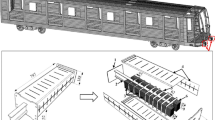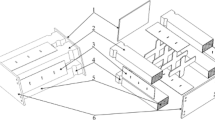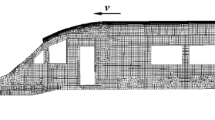Abstract
This paper presents a novel framework for predicting the crashworthiness of a square cone energy-absorbing (SCEA) structure using a machine-learning method. The structure consists of an anti-creep, a thin-walled structure with nonuniform thickness, diaphragms, two types of aluminum honeycombs and a guide rail. The finite element model of SCEA structure was established and validated by full-scale experimental test. Taking the thicknesses of thin walls (TA and TB) and diaphragms (Tgb), strengths of honeycombs (δA and δB) as parametric variables, the parameters of SCEA structure were changed based on a virtual design of experiments (DOE) to generate training data and test data. To improve the crashworthiness of SCEA structure, the structural parameters were employed as input data, four machine learning models were utilized to predict the energy-absorbing characteristic curve of the SCEA structure, and the prediction accuracy of different models was compared and analyzed. According to the results of comparison, the Gate Recurrent Unit (GRU) model was chosen to predict the structural energy-absorbing characteristics, also employed as the input of optimization. The energy absorption (EA) and initial peak crushing force (PCF) were adopted as objectives, and the global response surface method (GRSM) was employed as the optimization algorithm. The results showed that the optimal solution was obtained as PCF = 618.41 kN and EA = 297.99 kJ when TA = 2.1 mm, TB = 2.9 mm, Tgb = 2.4 mm, δA = 5.99 MPa and δB = 4.82 MPa. The machine learning method offers engineers and scientists a potential tool to accelerate the design and optimization of SCEA structures for rail vehicles.


















Similar content being viewed by others
References
Altin M, Guler MA, Mert SK (2017) The effect of percent foam fill ratio on the energy absorption capacity of axially compressed thin-walled multi-cell square and circular tubes. Int J Mech Sci 131:368–379
Ambrósio J, Carvalho M, Milho J, Escalante S, Martín R (2021) A validated railway vehicle interior layout with multibody dummies and finite element seats models for crash analysis. Multibody Syst Dyn 54(2):179–212
ASME RT-2-2014 (2014) Safety standard for structural requirements for heavy rail transit vehicles. The American Society of Mechanical Engineers
Baharudin ME, Rouvinen A, Korkealaakso P, Mikkola A (2014) Real-time multibody application for tree harvester truck simulator. Proc Inst Mech Eng K 228(2):182–198
Baykasoglu C, Sunbuloglu E, Bozdag SE, Aruk F, Toprak T, Mugan A (2011) Railroad passenger car collision analysis and modifications for improved crashworthiness. Int J Crashworthiness 16(3):319–329
Bengio Y, Simard P, Frasconi P (1994) Learning long-term dependencies with gradient descent is difficult. IEEE Trans Neural Netw 5:157–166
Chen TT, Zhang Y, Lin JM, Lu Y (2019) Theoretical analysis and crashworthiness optimization of hybrid multi-cell structures. Thin-Walled Struct 142:116–131
Dehnaw AM, Manie YC, Chen YY, Chiu PH, Huang HW, Chen GW, Peng PC (2020) Design reliable bus structure distributed fiber Bragg grating sensor network using gated recurrent unit network. Sensors 20(24):7355
Duddeck F, Hunkeler S, Lozano P, Wehrle E, Zeng D (2016) Topology optimization for crashworthiness of thin-walled structures under axial impact using hybrid cellular automata. Struct Multidisc Optim 54(3):415–428
EN15227:2020 (2020) Railway applications—crashworthiness requirements for rail vehicles. European Committee for Standardization, London
Gallardo-Antolin A, Montero JM (2021) Detecting deception from gaze and speech using a multimodal attention LSTM-based framework. Appl Sci 11(14):6393
Graves A, Mohamed AR, Hinton G (2013) Speech recognition with deep recurrent neural networks. In: IEEE international conference on acoustics, speech and signal processing, Canada, 26–31. pp 6645–6649
Greff K, Srivastava RK, Koutnik J, Steunebrink BR, Schmidhuber J (2017) LSTM: a search space odyssey. IEEE Trans Neural Netw Learn Syst 28(10):2222–2232
Guan WY, Gao GJ, Li J, Yu Y (2018) Crushing analysis and multi-objective optimization of a cutting aluminium tube absorber for railway vehicles under quasi-static loading. Thin-Walled Struct 123:395–408
Guan WY, Gao GJ, Yu Y, Zhuo TY (2020) Crashworthiness analysis and multi-objective optimization of expanding circular tube energy absorbers with cylindrical anti-clamber under eccentric loading for subway vehicles. Struct Multidisc Optim 61(4):1711–1729
Haghshenas M, Wood JT, Klassen RJ (2012) Investigation of strain-hardening rate on splined mandrel flow forming of 5052 and 6061 aluminum alloys. Mater Sci Eng 532:287–294
Hengstler M, Enkel E, Duelli S (2015) Applied artificial intelligence and trust—the case of autonomous vehicles and medical assistance devices. Technol Forecast Soc Change 105:105–120
Hochreiter JS (1997) Long short-term memory. Neural Comput 9(8):1735–1780
Hong W, Fan H, Xia Z, Jin F, Zhou Q, Fang D (2014) Axial crushing behaviors of multi-cell tubes with triangular lattices. Int J Impact Eng 63:106–117
Islam A, Chang K (2021) Real-time AI-based informational decision-making support system utilizing dynamic text sources. Appl Sci 11(13):6237
Jacobsen K, Tyrell D, Perlman B (2004) Impact test of a crash-energy management passenger rail car. In: ASME/IEEE joint rail conference. Baltimore, pp 19–26
Jang HJ, Shin KB, Han SH (2012) Numerical study on crashworthiness assessment and improvement of composite carbody structures of tilting train using hybrid finite element model. Adv Compos Mater 21(5–6):371–388
Jung J, Yoon K, Lee PS (2020) Deep learned finite elements. Comput Methods Appl Mech Eng 372(1):113401
Kang H, Kim J (2020) Damage mitigation of a steel column subjected to automobile collision using a honeycomb panel. J Perform Constr Facil 34(1):04019107
Kingma DP, Ba J (2014) Adam: A method for stochastic optimization. arXiv, 1412.6980
Kohar CP, Connolly DS, Liusko T, Inal K (2020) Using artificial intelligence to aid vehicle lightweighting in crashworthiness with aluminum. In: 17th international conference on aluminium alloys. Grenoble, France, p 01006
Kohar CP, Greve L, Eller TK, Connolly DS, Inal K (2021) A machine learning framework for accelerating the design process using CAE simulations: an application to finite element analysis in structural crashworthiness. Comput Methods Appl Mech Eng 385:114008
Levenberg K (1944) A method for the solution of certain non-linear problems in least squares. Q Appl Math 2(2):164–168
Li GY, Zhang ZS, Sun GY, Xu FX, Huang XD (2014) Crushing analysis and multi-objective optimization for functionally graded foam-filled tubes under multiple load cases. Int J Mech Sci 89:439–452
Li ZB, Chen R, Lu FY (2018) Comparative analysis of crashworthiness of empty and foam-filled thin-walled tubes. Thin-Walled Struct 124:343–349
Liu Q, Xy Xu, Ma JB, Wang JS, Shi Y, Hui D (2017) Lateral crushing and bending responses of CFRP square tube filled with aluminum honeycomb. Composites B 118:104–115
Mahjoub S, Chrifi-Alaoui L, Marhic B, Delahoche L (2022) Predicting energy consumption using LSTM, multi-layer GRU and Drop-GRU neural networks. Sensors 22(11):4062
Marquardt D (1963) An algorithm for least-squared estimation of non linear parameters. J Soc Ind Appl Math 11(2):431–441
Meiring GAM, Myburgh HC (2015) A review of intelligent driving style analysis systems and related artificial intelligence algorithms. Sensors 15(12):30653–30682
Pandya KS, Roth CC, Mohr D (2020) Strain rate and temperature dependent fracture of aluminum alloy 7075: experiments and neural network modeling. Int J Plast 135(5):102788
Pang T, Zheng G, Fang JG, Dong R, Sun GY (2019) Energy absorption mechanism of axially-varying thickness (AVT) multicell thin-walled structures under out-of-plane loading. Eng Struct 196:109130
Peng Y, Deng WY, Xu P, Yao SG (2015) Study on the collision performance of a composite energy-absorbing structure for subway vehicles. Thin-Walled Struct 94:663–672
Peng Y, Wang SM, Yao S, Xu P (2017) Crashworthiness analysis and optimization of a cutting-style energy absorbing structure for subway vehicles. Thin-Walled Struct 120:225–235
Rad MA, Khalkhali A (2018) Crashworthiness multi-objective optimization of the thin-walled tubes under probabilistic 3D oblique load. Mater Des 156:538–557
Rumelhart DE, Hinton GE, Williams RJ (1986) Learning representations by back-propagating errors. Nature 323(6088):533–536
Sak H, Senior A, Beaufays F (2014) Long short-term memory recurrent neural network architectures for large scale acoustic modeling. In: Proceedings of the annual conference of the International Speech Communication Association, 14–18. Singapore, pp 338–342
Song XG, Sun GY, Li GY, Gao WZ, Li Q (2012) Crashworthiness optimization of foam-filled tapered thin-walled structure using multiple surrogate models. Struct Multidisc Optim 47(2):221–231
Sun FF, Lai CL, Fan HL (2016a) In-plane compression behavior and energy absorption of hierarchical triangular lattice structures. Mater Des 100:280–290
Sun FF, Lai CL, Fan HL, Fang DN (2016b) Crushing mechanism of hierarchical lattice structure. Mech Mater 97:164–183
Sun GY, Chen DD, Wang HX, Hazell PJ, Li Q (2018a) High-velocity impact behaviour of aluminium honeycomb sandwich panels with different structural configurations. Int J Impact Eng 122:119–136
Sun GY, Li SF, Li GY, Li Q (2018b) On crashing behaviors of aluminium/CFRP tubes subjected to axial and oblique loading: an experimental study. Composites B 145:47–56
Tao Q, Liu F, Li Y, Sidorov D (2019) Air pollution forecasting using a deep learning model based on 1D convnets and bidirectional GRU. IEEE Access 7:76690–76698
Tyrell D, Severson K, Perlman AB (2000) Rail passenger equipment crashworthiness testing requirements and implementation. Rail Transp 19:67–76
Vinayagar K, Kumar AS (2017) Crashworthiness analysis of double section bi-tubular thin-walled structures. Thin-Walled Struct 112:184–193
Wang WB, Ren LH, Zhou HC, Hecht M (2012) Energy absorption configuration of crashworthy metro train. Adv Mater Res 466:724–728
Wang ZG, Tian HQ, Lu ZJ, Zhou W (2014) High-speed axial impact of aluminum honeycomb—experiments and simulations. Composites B 56:1–8
Wang ZG, Li ZD, Xiong WW (2019) Numerical study on three-point bending behavior of honeycomb sandwich with ceramic tile. Composites B 167:63–70
Wang C, Xu LY, Fan JS (2020) A general deep learning framework for history-dependent response prediction based on UA-Seq2Seq model. Comput Methods Appl Mech Eng 372:113357
Wei L, Zhang LL, Tong X, Cui K (2021) Crashworthiness study of a subway vehicle collision accident based on finite-element methods. Int J Crashworthiness 26(2):159–170
Wierzbicki TA (1983) On the crushing mechanics of thin-walled structures. J Appl Mech 50(4a):727–734
Wu SY, Sun GY, Wu X, Li GY, Li Q (2017) Crashworthiness analysis and optimization of Fourier varying section tubes. Int J Non-Linear Mech 92:41–58
Xiao YY, Yin HF, Fang HB, Wen GL (2016) Crashworthiness design of horsetail-bionic thin-walled structures under axial dynamic loading. Int J Mech Mater Des 12(4):563–576
Xie SC, Zhou H (2014) Multi-objective optimisation of a vehicle energy absorption structure based on surrogate model. J Cent South Univ 21(6):2539–2546
Xu P, Yang CX, Peng Y, Yao SG, Xing J, Li BH (2016) Cut-out grooves optimization to improve crashworthiness of a gradual energy-absorbing structure for subway vehicles. Mater Des 103:132–143
Xu P, Lu S, Yan KB, Yao SG (2019) Energy absorption design study of subway vehicles based on a scaled equivalent model test. Proc Inst Mech Eng F 233(1):3–15
Xu JM, Wang J, Wang P, Chen JY, Gao Y, Chen R, Xie KZ (2020) Study on the derailment behaviour of a railway wheelset with solid axles in a railway turnout. Veh Syst Dyn 58(1):123–143
Yang CX, Xu P, Yao SG, Xie SC, Li QM, Peng Y (2018) Optimization of honeycomb strength assignment for a composite energy-absorbing structure. Thin-Walled Struct 127:741–755
Yang CX, Meng K, Yang LT, Guo WN, Xu P, Zhou ST (2023) Transfer learning-based crashworthiness prediction for the composite structure of a subway vehicle. Int J Mech Sci. https://doi.org/10.1016/j.ijmecsci.2023.108244
Yao SG, Yan KB, Lu SS, Xu P (2018a) Prediction and application of energy absorption characteristics of thin-walled circular tubes based on dimensional analysis. Thin-Walled Struct 130:505–519
Yao SG, Li ZX, Yan JL, Xu P, Peng Y (2018b) Analysis and parameters optimization of an expanding energy-absorbing structure for a rail vehicle coupler. Thin-Walled Struct 125:129–139
Yao SG, Yan KB, Lu SS, Xu P (2019) Equivalence study involving rail vehicle collision test conditions. Proc Inst Mech Eng F 233(1):73–89
Yin HF, Wen GL, Liu ZB, Qing QX (2014) Crashworthiness optimization design for foam-filled multi-cell thin-walled structures. Thin-Walled Struct 75:8–17
Zarzycki K, Lawrynczuk M (2021) LSTM and GRU neural networks as models of dynamical processes used in predictive control: a comparison of models developed for two chemical reactors sensors. Sensors 21(16):5625
Zhang ZH, Liu ST, Tang ZL (2009) Crashworthiness investigation of kagome honeycomb sandwich cylindrical column under axial crushing loads. Thin-Walled Struct 48(1):9–18
Zhang Y, Xu X, Wang J, Tt C, Wang CH (2019) Crushing analysis for novel bio-inspired hierarchical circular structures subjected to axial load. Int J Mech Sci 140:407–431
Zhao R, Wang DZ, Yan RQ, Mao KZ, Shen F, Wang JJ (2018) Machine health monitoring using local feature-based gated recurrent unit networks. IEEE Trans Ind Electron 65(2):1539–1548
Zhou H, Xu P, Xie SC (2017) Composite energy-absorbing structures combining thin-walled metal and honeycomb structures. Proc Inst Mech Eng F 231(4):394–405
Acknowledgements
The authors would like to acknowledge the financial support from the Hunan Provincial Natural Science Foundation of China (No. 2022JJ40619, 2023JJ20074), the Fundamental Research Funds for the Central Universities of Central South University (No. 512340040, 202044019), the Young Elite Scientists Sponsorship Program by CAST (No. 2022QNRC001), the Changsha Municipal Natural Science Foundation (No. kq2202102), the National Key Research and Development Program of China (No. 2021YFB3703801), and the open project of Key Laboratory of Conveyance and Equipment of Ministry of Education, East China Jiaotong University (No. KLCE2022-06).
Funding
The authors would like to acknowledge the financial support from the Hunan Provincial Natural Science Foundation of China (No. 2022JJ40619, 2023JJ20074), the Fundamental Research Funds for the Central Universities of Central South University (No. 512340040, 202044019), the Young Elite Scientists Sponsorship Program by CAST (No. 2022QNRC001), the Changsha Municipal Natural Science Foundation (No. kq2202102), the National Key Research and Development Program of China (No. 2021YFB3703801), and the open project of Key Laboratory of Conveyance and Equipment of Ministry of Education, East China Jiaotong University (No. KLCE2022-06).
Author information
Authors and Affiliations
Corresponding author
Ethics declarations
Conflict of interest
The authors declare that they have no conflict of interest.
Replication of results
The data used to support the findings of this study are available from the corresponding author upon request.
Additional information
Responsible Editor: Axel Schumacher
Publisher's Note
Springer Nature remains neutral with regard to jurisdictional claims in published maps and institutional affiliations.
Rights and permissions
Springer Nature or its licensor (e.g. a society or other partner) holds exclusive rights to this article under a publishing agreement with the author(s) or other rightsholder(s); author self-archiving of the accepted manuscript version of this article is solely governed by the terms of such publishing agreement and applicable law.
About this article
Cite this article
Guo, W., Xu, P., Yang, C. et al. Machine learning-based crashworthiness optimization for the square cone energy-absorbing structure of the subway vehicle. Struct Multidisc Optim 66, 182 (2023). https://doi.org/10.1007/s00158-023-03629-2
Received:
Revised:
Accepted:
Published:
DOI: https://doi.org/10.1007/s00158-023-03629-2




